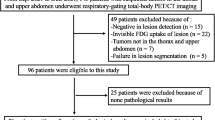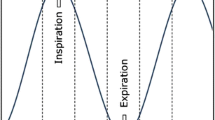Abstract
Objective
Respiratory gated PET/CT (positron emission tomography/computed tomography) of the lung is expected to increase the accuracy of quantitative determinations in lesional activities, regardless of the gating method used; reasonably, respiratory gating should increase standard uptake value (SUV; and possibly decrease lesional size), on the basis of the reduction of the “smearing effect.” However, literature data are very limited, particularly for in vivo studies. The objective of this article is to test the SUV variations in a large group of lung lesion studies.
Methods
A group of 26 consecutive positive studies (21 men, 5 women, age 36-84, mean 68), performed on patients referred to our institution for known or suspected lung cancer, are examined. All studies were performed both with conventional PET/CT total body scan and with Real-Time Position Management (RPM) triggered selective gated study of the thorax. Four studies were considered technically unsatisfactory and were discarded; the remaining 22 studies are the object of this work. Max lesional SUVs were evaluated in both settings by semi-automated algorithms; for the gated studies, both values of the bin that showed more relevant variations from the clinical routinary study (“best bin”) and an average value that was calculated over all bins were determined. Results were compared on a one-to-one basis.
Results
In conventional, SUV showed a mean ± standard deviation (SD) value of 9.2 ± 6.9 (range 0.9–26). In the averaged gated studies, the mean ± SD value was 13.4 ± 11.7 (range 1.4–47); in the “best bin” dataset the mean ± SD was 14.9 ± 12.9, ranging from 1.6 to 53.1. In general, the use of respiratory trigger induced rather variable but overall consistent increases in SUV. If the percentage variations in the average trigger dataset are considered, there is an average increase of +60%, SD ± 97 (P < 0.05). Similar results are found in the “best bin” dataset, the average percentage increase in SUV values being +77.2% (SD ± 04.6).
Conclusions
In lung cancer, triggering procedures increase the signal to noise ratio. The increase in SUV determined by gating is very variable, but generally relevant. This could lead to an SUV values cut-off revision, and may have an impact on smaller lesions detection.
Similar content being viewed by others
References
De Leyn P, Lardinois D, Van Schil PE, Rami-Porta R, Passlick B, Zielinski M, et al. ESTS guidelines for preoperative lymph node staging for non small cell lung cancer. Eur J Cardiothorac Surg 2007;32:1–8.
De Leyn P, Lardinois D, Van Schil PE, Rami-Porta R, Passlick B, Zielinski M, et al. European trends in preoperative and intraoperative nodal staging: ESTS guidelines. J Thorac Oncol 2007;2:357–361.
Ashamalla H, Rafla S, Parik K, Mokhtar B, Goswami G, Kambam S, et al. The contribution of integrated PET/CT to the evolving definition of treatment volumes in radiation treatment planning in lung cancer. Int J Radiat Oncol Biol Phys 2005;63:1016–1023.
De Wever W, Vankan Y, Stroobants S, Verschakelen J. Detection of extrapulmonary lesions with integrated PET/CT in the staging of lung cancer. Eur Respir J 2007;29:995–1002.
Lupi A, Vidali M, Salgarello M, Schiavon S, Bicego E, Negrin R, et al. PET and PET/CT in diagnosis and staging of lung neoplasms. Eur J Nucl Med 2004;31:S350.
von Schulthess G. Clinical molecular anatomic imaging. Philadelphia: Lippincott Williams & Wilkins, pp. 253–255.
Goerres G, Kamel E, Heidelberg T, Schwitter MR, Burger C, von Schulthess GK. PET-CT image co-registration in the thorax: influence of the respiration. Eur J Nucl Med 2002;29:351–360.
Goerres W, Kamel E, Seifert B, Burger C, Buck A, Hany TF, et al. Accuracy of image coregistration of pulmonary lesions in patients with non small cell lung cancer using an integrated PET/CT system. J Nucl Med 2002;43:1469–1475.
Soret M, Bacharach SL, Buvat I. Partial-volume effect in PET tumor imaging. J Nucl Med 2007;48:932–945.
Quiao F, Pan T, Clark J Jr, Mawlawi OR. A motion incorporated reconstruction method for gated PET studies. Phys Med Biol 2006;51:3769–3783.
Erdi YE, Nehmeh SA, Pan T. The CT motion quantitation of lung lesions and its impact on PET-measured SUVs. J Nucl Med 2004;45:1287–1292.
Pevsner A, Nehmeh SA, Humm JL, Mageras GS, Erdi YE. Effect on motion on tracer activity determination in CT attenuation corrected PET images: a lung phantom study. Med Phys 2005;32:2358–2364.
Dawood M, Büther F, Lang N, Schober O, Schaefers KP. Respiratory gating in positron emission tomography: a quantitative comparison of different gating schemes. Med Phys 2007;34:3067–3076.
Bundschuh RA, Martinez-Moeller A, Essler M, Martinez MJ, Nekolla SG, Ziegler SI, et al. Postacquisition detection of tumor motion in the lung and upper abdomen using list-mode PET: a feasibility study. J Nucl Med 2007;48:758–763.
Nehmeh SA, Erdi YE, Ling CC, Rosenzweig KE, Cchoder H, Larson SM, et al. Effect of respiratory gating on quantifying PET images of lung cancer. J Nucl Med 2002;43:876–881.
Erdi YE, Nehmeh SA, Pan T, Pevsner A, Rosenzweig KE, Mageras G, et al. The CT motion quantitation of lung lesions and its impact on PET measured SUVs. J Nucl Med 2004;45:1287–1292.
Nehmeh SA, Erdi YE, Pan T, Pevsner A, Rosenzweig KE, Yorke E, et al. Four-dimensional (4D) PET/CT imaging of the thorax. Med Phys 2004;31:3179–3186.
Nehmeh SA, Erdi YE, Meirelles GSP, Squire O, Larson SM, Humm JL, et al. Deep inspiration breath-hold PET/CT of the thorax. J Nucl Med 2007;48:22–26.
Beyer T, Antoch G, Blodgett T, Freudenberg L, Akhurst T, Mueller S. Dual modality PET/CT imaging: the effect of the respiratory motion on combined image in clinical oncology. Eur J Nucl Med 2003;30:588–596.
Goerres GW, Kamel E, Heidelberg TH, Schwitter MR, Burger C, von Schulthess GK. PET-CT image co-registration in the thorax: influence of respiration. Eur J Nucl Med 2002;29:351–360.
Bailey D, Kalemis A. Externally triggered gating of nuclear medicine acquisitions: a useful method for partitioning data. Phys Med Biol 2005;50:N55–N62.
Starkschall G, Desai N, Balter P, Prado K, Luo D, Cody D, et al. Quantitative assessment of four-dimensional computed tomography image acquisition quality. J Appl Clin Med Phys 2007;8:1–20.
Wolthaus JWH, van Herk M, Muller SH, Belderbros JS, Lebesque JV, DeBois JA, et al. Fusion of respiration-correlated PET and CT scans: correlated lung tumor motion in anatomical and functional scans. Phys Med Biol 2005;50:1569–1583.
Boucher L, Rodrigue R, Lecomte R, Benard F. Respiratory gating for 3 dimensional PET of the thorax: feasibility and initial result. J Nucl Med 2004;45:214–219.
Nehmeh SA, Erdi YE, Rosenzweig KE, Schoder H, Larson SM, Squire OD, et al. Reduction of respiratory motion artifacts in PET imaging of lung cancer by respiratory correlated dynamic PET: methodology and comparison with respiratory gated PET. J Nucl Med 2003;44:1644–1648.
Wagman R, Yorke E, Ford E. Respiratory gating for liver tumors: use in dose escalation. Int J Radiat Oncol Biol Phys 2003;55:659–668.
Kohlmyer S, Alessio A, Fessler J. 4d temporal smoothing with respiratory induced Fourier filter (RIFF). J Nucl Med 2007:48(Suppl 2):197P.
Larson SM, Nehmeh SA, Erdi YE, Humm JL. PET/CT in non-small-cell lung cancer: value of respiratory-gated PET. Chang Gung Med J 2005;28:306–314.
Author information
Authors and Affiliations
Corresponding author
Rights and permissions
About this article
Cite this article
Lupi, A., Zaroccolo, M., Salgarello, M. et al. The effect of 18F-FDG-PET/CT respiratory gating on detected metabolic activity in lung lesions. Ann Nucl Med 23, 191–196 (2009). https://doi.org/10.1007/s12149-008-0225-1
Received:
Accepted:
Published:
Issue Date:
DOI: https://doi.org/10.1007/s12149-008-0225-1




